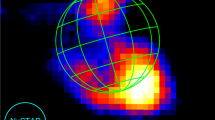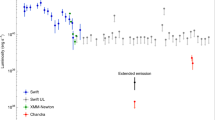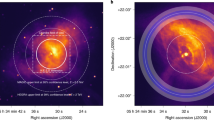Abstract
A LINE feature has been observed1–4 in the hard X-ray (E≈58 keV) spectrum of the compact X-ray source Hercules X–1. If this were interpreted as a cyclotron line emission from a strong magnetic field (B≳1012G), then the observations could be used to place strict limits on the total source luminosity in the cyclotron line. The salient feature of the observed line emission is that the FWHM is <12 keV (ref. 1), with a total observed luminosity in the line of approximately 1% of the total X-ray luminosity. The line seems to be pulsed in phase with the 1.24s hard X-ray pulse2. If we understand, even vaguely, the physical conditions at the pole of an accreting neutron star, as in Her X–1, we would expect a lot of cyclotron emission. For a temperature of kTe≈20 keV, as inferred from the X-ray spectral data5, and a strong magnetic field (B≈5×1012 G), as inferred by flux conservation, it is easy to excite the electrons, either by collisions or by blue-shifted photo-excitation. For a neutron star with such a magnetic field and a gravitational redshift of 0.1, the fundamental harmonic of the cyclotron radiation appears at approximately 58 keV. In the data of Trumper et al.1, there is some evidence for the second harmonic, tending to give credence to the reality of the interpretation. If the line emission is real and the hard X-ray pulse is due to the occultation of a more isotropic hard X-ray emission by a shell of gas at the neutron star magnetosphere6,7, the calculations presented here indicate that the total source luminosity of the cyclotron line is more than an order of magnitude greater than the observed amount.
This is a preview of subscription content, access via your institution
Access options
Subscribe to this journal
Receive 51 print issues and online access
$199.00 per year
only $3.90 per issue
Buy this article
- Purchase on Springer Link
- Instant access to full article PDF
Prices may be subject to local taxes which are calculated during checkout
Similar content being viewed by others
References
Trümper, J. et al. Astrophys. J. Lett. 219, L105–L110 (1978).
Kendziorra, E. et al. Astrophys. J. Lett. 217, L93–L96 (1977).
Voges, W. et al. IAU Circ. No. 3184 (1978).
Coe, M. J., Engel, A. R., Quenby, J. J. & Dyer, C. S. Nature 268, 508–509 (1977).
Pravdo, S. H. thesis, Univ. Maryland (1976).
McCray, R. & Lamb, F. K. Astrophys. J. Lett. 204, L115–L118 (1976).
Basko, M. M. & Sunyaev, R. A. Mon. Not. R. astr. Soc. 175, 395 (1976).
Shulman, S. et al. Astrophys. J. Lett. 199, L101–L104 (1975).
Catura, R. C. & Acton, L. W. Astrophys. J. Lett. 202, L5–L7 (1975).
Joss, P. C. et al. Astrophys. J. 214, 874–878 (1977).
Meszaros, P. Astr. Astrophys. 63, L19–L22 (1978).
Weaver, R. P. Astrophys. J. Lett. (submitted).
Ross, R. R., Weaver, R. & McCray, R. Astrophys. J. 219, 292–299 (1978).
Langer, S., Ross, R. R. & McCray, R. Astrophys. J. (in the press).
Author information
Authors and Affiliations
Rights and permissions
About this article
Cite this article
WEAVER, R. Consequences of narrow cyclotron emission from Hercules X–1. Nature 274, 571–572 (1978). https://doi.org/10.1038/274571a0
Received:
Accepted:
Issue Date:
DOI: https://doi.org/10.1038/274571a0
This article is cited by
Comments
By submitting a comment you agree to abide by our Terms and Community Guidelines. If you find something abusive or that does not comply with our terms or guidelines please flag it as inappropriate.



